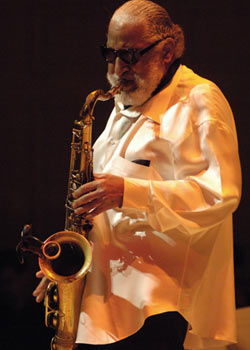The lines were around the block for will-call and walk-up ticket purchases at Symphony Hall Sunday night — causing the show to start a half hour after its advertised curtain time. The place was nearly full, the mood celebratory. All good to see in a down economy. But this was the first disappointing Sonny Rollins concert I’ve attended in years.

Photo: Eric Antoniou |
It started great guns — Sonny blasting the urgent three-note riff of “Patanjali,” using that motivic kernel as a platform for soaring long-toned melodic phrases, raspy atonal clusters, smooth bebop runs. All over a funk vamp. He’d jump to the top of his register, sail into some adjacent keys, dive down to his honking low notes, come back to the three-note tattoo. And the rhythm section responded in kind, pushing Sonny as he pushed them. For the first 15 minutes, it looked as though this would be an extraordinary night.
The Latin beat of the second number, “Memsa,” was anchored by the tock of Kobie Watkins’s snare rim and percussionist Victor See-Yuen’s triangle. Once again, here was that Sonny sound: big and robust, emphatically altering the color of a two-note phrase so that it carried the weight of a chorus, trading riffs with guitarist Bobby Broom.
Then came “Serenade,” a waltz that pretty much stopped the evening in its tracks when Sonny engaged in an extended series of 4’s with Watkins. Fours are traditionally used as a detour on the out-chorus. Here it was the interminable beginning, middle, and end. When it sounded like Sonny was transitioning into a cadence, the audience would applaud . . . but the 4’s continued.
Then came Rollins’s relatively new ballad, “J.J.” — a thus far unrecorded tribute to his former mentor J.J. Johnson. With a halting swing cadence and fanfare bebop tag, it never found a groove, and if I didn’t know better I’d say that Watkins and See-Yuen had never played it before. It turned into a feature for Broom. His sharp chording had contributed to the rhythmic heat of “Patanjali,” but here he drifted off into empty noodling before Sonny returned with a couple of broad, attractive statements of the melody. Tune over.
Next came “Global Warming,” one of Sonny’s crowd-pleasing calypsos, and it sounded like the show might regain some traction. Here as in the other numbers, Sonny comped along with Broom, but the guitarist’s tone — watery and unfocused in the resonant hall — by necessity fell into the background of the more robust tenor. Sonny dropped out for a bit, giving Broom a chance to dig in and nearly find some momentum. Sonny returned, sounding good, playing one of his off-the-cuff quotations (“Time After Time”) and came out to the apron of the stage to jab the folks in the front rows with his riffing.
Then — a bit bandy-legged, but still resplendent in shades, swept-back steel-gray hair, white flowing shirt, and dark trousers — he came over to the microphone stage right, made introductions, said he was “sorry you guys lost those games,” then went into what turned out to be the final number of the night, a medium-tempo blues. Here was another meandering Broom solo, and by this time I was ready to throw a shoe at him. When Sonny came in, it was just to comp. For a moment, it looked like he was gearing up for another solo — with four measures of hard staccato blasts on the downbeat. But that was it. Amidst the ovation he promised to be back. “Soon!” he said. And repeated: “Soon! . . . Soon!”